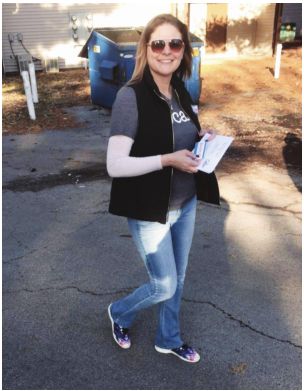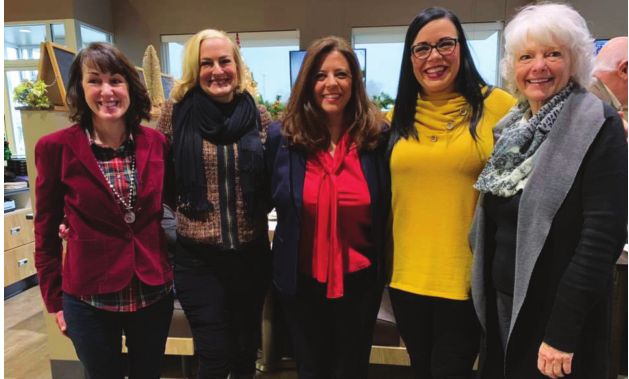
Lisa Badger, a first-time candidate for office who is running for the Springfield Park District Board, says she decided to run because she “feels strongly there should be diversity in government.” Badger and Park District Board president Leslie Sgro are the only two women in the race. If they win, the board will remain representative of Springfield’s population, at least when considering gender. “I do think government should reflect all people,” Badger said.
Women account for approximately 52 percent of the population in Springfield and Sangamon County, according to early estimates from the Census Bureau, yet their representation as elected officeholders doesn’t align with that statistic.
Out of 127 people running for office in Sangamon County, 44 percent are women. However, female candidates in Springfield city elections are at roughly 38 percent, an improvement when compared to prior municipal elections.
“What we’re witnessing is a gradual process,” said Carol Moseley Braun, the first woman, as well as the first African-American woman, elected as a U.S. senator from Illinois.
“Change doesn’t happen overnight, and that it’s happening warms my heart. I’m very pleased to see the direction our politics are going,” said Mosley Braun, who now teaches political science classes at Northwestern University in Evanston, Illinois.
National surge
The 2018 election cycle had a historic number of female candidates. A similar phenomenon occurred in 1992, which was dubbed the Year of the Woman.
Much like the 1992 elections, female candidates in 2018 were responding to something they found abhorrent. Then, it was the sexual harassment allegations Anita Hill recounted during a 1991 televised Senate Judiciary Committee hearing about the vulgar and inappropriate behavior she had endured from Clarence Thomas before his confirmation to the U.S. Supreme Court. In 2018, it was Christine Blasey Ford delivering testimony before the Senate Judiciary Committee about what she characterized as an attempted sexual assault against her by Brett Kavanaugh when they were teenagers. Despite the women’s testimony, Thomas and Kavanaugh were subsequently confirmed to serve on the U.S. Supreme Court.
Another occurrence that was mirrored in 1992 and 2018 was the number of seats left open from incumbents who retired, creating an opportunity for new candidates.
The difference between 1992 and 2018 is President Donald Trump.
Sheila Stocks-Smith, former Springfield mayoral candidate, said the number of females running in local elections this year is unprecedented, and she can think of one person who helped influence the surge.
“I would argue Donald Trump is recruiting candidates,” Stocks-Smith said. “This is what’s happening nationally since Trump’s election. Women are stepping up and realizing the need to be involved at all levels.”
Trump has been the focal
point of many outspoken activists who disagree with the language he uses
toward women, his denial of climate change and what some would say are
overtly racist policies, to name a few.
“The
way he is governing has unleashed a lot of pent-up activism,” said
Doris Turner, chair of the Sangamon County Democratic Party. “I think
that people are seeing that they really need to step up and become more
active, not only in national politics, but local politics as well.”
Underrepresentation and partisan disparities
Illinois
women remain underrepresented in Congress, with just 17 females elected
to the House since 1921 and two serving as senators.
The
first woman to win a congressional seat in Illinois was U.S. Rep.
Winnifred S.M. Huck in 1921, who was elected to fill a vacancy that was
left open after her father’s death. She served in her role for a year.
Huck was elected to office nine years after the Illinois General
Assembly voted to allow women to vote in presidential elections.
However, Illinois voters didn’t elect a female congressional senator
until Moseley Braun in 1992. Since then, Illinois has elected one other
female senator, U.S. Senator Tammy Duckworth, who also served as a
congressional representative from 2013 to 2017.
Moseley Braun said the increase in female candidates was bound to
happen, and she’s glad to bear witness to what she believes is the
strengthening of democracy. “This gender inequity is not partisan; it’s
on both side of the aisle,” Moseley Braun said. “This is about
enlivening our democracy.”
The
issue of disparity between the female population and female
officeholders isn’t isolated to national elections. In the Illinois
General Assembly, female lawmakers currently represent 36.2 percent of
the chambers, the most representation women have had since the creation
of the General Assembly. When comparing the partisan breakdown of female
lawmakers, Republican women are severely underrepresented since the
majority of the females elected are Democrats.
That
same trend appears on the local level. The increase of female
candidates in city elections also tends to lean left, with more women
seeking endorsement by Democrats than Republicans, although the
municipal elections are officially considered nonpartisan.
“ ”
Women stepping out and into office was really bucking the system and swimming upstream. Now, it’s not unexceptional.
– Carol Moseley Braun
Turner, the Sangamon County Democratic Party chair, said the group has yet to decide on endorsements for the upcoming elections.
The
Sangamon County Republican Central Committee, which has endorsed five
female candidates in countywide elections, reported during a recent call
that most of the people running the office are female.
Turner
said that while women have been involved in politics in the past, they
usually played a supportive role, as opposed to running for office. “We
have always had a large number of women who’ve been involved,” Turner said. “They’ve been involved in a number of campaigns.”
Regardless
of what role women play in politics, whether they are at the forefront
as a candidate or in a supporting role on the campaign, Democrats and
Republicans have different views on choosing candidates for office.
“There’s
a fundamental difference in primary voters and the importance they
place on women,” said Christine Matthews, the president of public
opinion research company Bellwether Research and Consulting. “Republican
primary voters don’t think it’s important to elect women because
they’re women and Democratic primary voters do.”
Matthews
said Republicans believe endorsing a candidate simply because of their
gender is identity politics, a strategy used by Democrats, and fails to
place emphasis on a candidate’s qualifications.

Additionally,
Matthews said females were energized after the election of Trump,
because of some of his rhetoric and his threat to repeal the Affordable
Care Act. She said women who run for office typically do so because of
their opinion on a specific issue, such as health care or gun control.
“They tend to be galvanized by issues, they’re not running out of a sense of ambition,” Matthews said.
Whether
women receive a party endorsement because they’re the most qualified
for the job, or they are selected to provide more diversity, is a point
both parties will need to address. However, Moseley Braun said the
addition of women in politics has created a necessary voice and had a
profound impact when lawmakers shape policies. In addition, the presence
of women in politics can also encourage more females to run for office.
Lakeisha Purchase, an aldermanic candidate for Ward 5, said when she
was around the age of 12 she would see her godmother, state Sen.
Kimberly Lightford, participate in political meetings. That exposure,
along with the support she has received from other women, gave Purchase
the confidence that she herself could run for office.
Park board candidate Badger said it’s comforting to know that support for fellow women is just a text or phone call away.
“It’s
empowering at times, as a woman, to know that we have a lot of really
great, smart, caring and driven women that want to make a difference and
want better for our community,” Badger said.
Springfield candidates
It’s
certainly not new to have women running for office in Springfield and
Sangamon County. After all, back in 1995, Springfield voters elected
Karen Hasara as mayor, and she served for two consecutive terms. The
first woman to get a seat at the city council table was Republican Gwenn
Klinger in 1991.
Currently,
out of the 10 aldermen elected to the council, only two are women. If
female candidates running in the ward races win in April, there could be
as many as six women sitting on the council.
The
city treasurer’s office and Ward 6 will have a female representative
regardless of who wins. Both incumbents are being challenged by female
candidates.
Buscher,
who’s running against Jennifer Notariano for treasurer, is the only
female city candidate backed by the Sangamon County Republican Central
Committee. Buscher said she “came from a mandominated world” before
running for treasurer. She said females existed in banking but took
positions that are more rank-andfile, such as customer service
representatives.
Now, she said, she sees more females seeking powerful positions in banking and sees a similar trend in politics.
“It’s
very similar to my background, I feel. Politics is heavy with
male-dominance, but I think it’s slowly becoming a little bit more
[populated] with females who are comfortable enough to run,” Buscher
said.
Ward 6
Alderwoman Kristin DiCenso is facing a challenge from political newcomer
Elizabeth Jones. DiCenso won a 2017 special election to fill a vacancy
left by Alderman Cory Jobe, which doubled the number of women on the
council to two. The only time more than two women have
served on the council occurred briefly between 2002 and 2003 when Mary
Pat Madonia finished her husband’s term after his death.
“It’s
not like I’m shattering any glass ceiling here, but when it comes to
city council, it has been predominantly a male body,” DiCenso said. “As
far as the volume of females running, this is a nationwide phenomenon.
This isn’t just unique to Springfield. This is the goal.”
Stocks-Smith,
who is a longtime Democratic activist, created a support group which
includes DiCenso, Badger, Purchase, Notriano and other women who are
running for election. The group helps the women share ideas about
campaigns, but it also gives them a support system that they can rely on
when overcoming obstacles.
“Doris
was definitely there every step of that way,” Purchase said, describing
the support she received from other women. “I was able to call her at
11:30 at night and she picked up the phone at home.”
Although it’s not a completely balanced representation, the current
consolidated race in Springfield is part of trend that shows more
females are running for office each election cycle.
“ ”
As far as the volume of females running, this
is a nationwide phenomenon. This isn’t just unique to Springfield. This
is the goal.
– Ward 6 Ald. Kristin DiCenso
“Women do bring a
different element to the operation of government that’s been missing,
and I think it’s been perfecting our democracy to have more women
involved,” Moseley Braun said.
Some
would argue that the reason female elected officials aren’t reflective
of the population is because females don’t run for leadership positions
as often as men.
“The
good news is that’s no longer true,” said Moseley Braun. “When I came
through, that was more often the case. Women stepping out and into
office was really bucking the system and swimming upstream. Now, it’s
not unexceptional.”
Lindsey
Salvatelli is an editorial intern with Illinois Times as part of the
Public Aff airs Reporting master’s degree program at University of
Illinois Springfi eld. Contact her at [email protected].